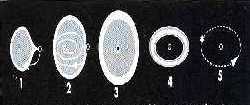Star hunger
 A BRITISH astronomer may be the first to have witnessed a bizarre celestial phenomenon: the formation of strange heavenly bodies when a superdense neutron star -- one that has been crushed by its own gravity -- insinuates itself inside a red giant star and transforms it (Science, Vol 262, No 5134).
A BRITISH astronomer may be the first to have witnessed a bizarre celestial phenomenon: the formation of strange heavenly bodies when a superdense neutron star -- one that has been crushed by its own gravity -- insinuates itself inside a red giant star and transforms it (Science, Vol 262, No 5134).
Philip Charles of Oxford University observed certain bright stars seem to be trapped in orbit around massive objects such as neutron stars and black holes. On analysing the light from these stars, Charles found the stars to be abnormally rich in lithium, which is a legacy of Thorne-Zytkow objects. But Charles realised that he may have glimpsed the celestial hybrid only when he compared his notes with those of Philipp Podsiadlowski, a theorist from Cambridge University.
The existence of Thorne-Zytkow objects was postulated as early as 1975 by Kip Thorne of the California Institute of Technology and Cambridge University's Anna Zytkow. According to their theory, these celestial objects are formed when a neutron star is in close orbit around a red giant star -- a massive and expanding star. The powerful gravity of the neutron star siphons matter from its younger giant companion and eventually, the neutron star drills into its fellow-star, sinks like a stone to its centre and starts destroying it.
Even though these bodies look like ordinary stars, there is lot of strange and wonderful stuff going on inside, say astrophysicists. The neutron core keeps pulling matter inward, compressing and heating it to generate 10 times more heat than the star's original core did. As a result, the star's outer layers churn vigorously, forging heavy elements not seen in ordinary stars -- molybdenum, yttrium, and rubidium, for example.
Last year, Podsiadlowski and Garrett Beale, a former student of Thorne, independently predicted large amounts of lithium also could be one of the elements produced -- just what Charles observed in the light from three stars.
Podsiadlowski reckons that after forging huge amounts of lithium and other elements, the neutron star may have exhausted its fuel, started a runaway contraction and exploded, throwing the remains of the giant star into a disk. This material, says Podsiadlowski, may have coalesced into a new companion star, which he thinks is what Charles has spotted.
Related Content
- Kitui residents face hunger in 2018 as food crops wilt
- Sh2.5bn needed to avert hunger
- Baringo poor call for food help amid rising hunger — thousands helpless
- Sh24bn needed to fight hunger, says State House
- Southern Africa bracing for acute food shortages – report
- Lesotho gov’t sets aside US$130m for drought relief
